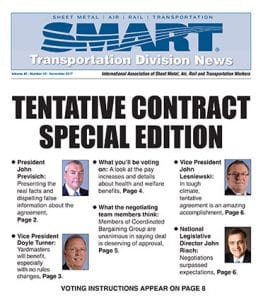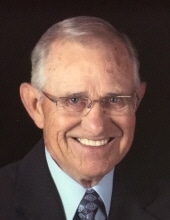Click here or the image below to read the special edition of SMART TD News about the proposed National Rail Agreement.
Author: bnagy
Clyde Larson, 62, described as “an absolute pillar” of the railroad labor community in northern Minnesota and Wisconsin, died on Nov. 8.
“Brother Clyde was a tremendously generous person and assisted all crafts,” said SMART TD Minnesota Legislative Director Phillip Qualy. “Clyde helped an untold number of railroad workers and our families with railroad and non-railroad matters.”

He also served as Local 1292’s Local and General Chairperson from the late 1980s to 2010, protecting one of the most lucrative steel road contracts in the United States.
He also served as legislative representative on the Minnesota Legislative Board from 2003 to 2009.
Brother Larson had served as a field investigator for the designated counsel law firm Hunegs, LeNeave and Kvas since 2010.
Clyde was serving our members in the union hall (Local 832/1175) to his final day. His ongoing dedication to his brothers and sisters of railroad labor was truly remarkable.
Brother Larson is survived by his wife, Anne, three sons, Scott, Eric, and Corey, two grandchildren and his father, Dexter Larson.
Visitation will be 5-7 p.m., with a wake prayer at 5 p.m., Tuesday, Nov. 14, at Dougherty Funeral Home in Duluth. Visitation will continue from 10-11 a.m., followed by the Mass of Christian Burial at 11 a.m., Wednesday, Nov. 15, at St. Lawrence Church in Duluth. Burial will be in Calvary Cemetery.
SMART TD extends its condolences to Clyde’s family and friends.
SaveSave
After derailments, blocked crossings and other complications, two members of the U.S. House of Representatives’ Committee on Transportation and Infrastructure have asked for the federal Government Accountability Office to study the effects of longer freight trains.
In the letter dated Nov. 7, ranking members Peter DeFazio, D-Ore., and Michael E. Capuano, D-Mass., made the request after referencing the derailment Aug. 2 of a CSX train in Hyndman, Pa.
The derailment of 32 cars from the train that consisted of five locomotives and 178 rail cars caused the evacuation of about 1,000 town residents and destroyed a house. The representatives noted in their letter that the average freight train consists of about 70 cars.
“Recent press reports indicate that some railroads are now operating trains with close to 200 or more cars that are more than two miles long,” they wrote. “We have concerns that longer trains can create unusually long delays at grade crossings and may pose safety risks to train crews and the public.”
DeFazio, a ranking member on the House Transportation and Infrastructure Committee, and Capuano, a ranking member on the Railroad Subcommittee, also mentioned operational challenges for rail workers, such as possible loss of radio contact, or service delays as a direct result of the longer trains.
“We appreciate that these congressional leaders have asked for a review of these dangerously long trains.” SMART-TD President John Previsich. “This issue was also addressed by John Risch, our national legislative director, at a recent STB hearing.”
Risch appeared Oct. 11 in Washington D.C. before the Surface Transportation Board at a listening session focused on problems with CSX’s service.
“Urging CSX to do better will not fix the problems that excessively long trains cause,” Risch said during his testimony. See a full article and video of that testimony here.
DeFazio and Capuano’s letter asks the GAO to look into various aspects of longer trains from the perspective of rail worker and public safety and also to examine the levels of oversight available on the federal, state and local levels to remedy safety concerns posed by longer trains.
To read the letter, follow this link.
These comments are on behalf of the Transportation Division of the International Association of Sheet Metal, Air, Rail and Transportation Workers (SMART). The SMART Transportation Division, formerly the United Transportation Union, is an organization representing approximately 125,000 transportation employees with active rail members in all operating crafts, including engineers, conductors, trainmen, switchmen and yardmasters.
This is in response to the PHMSA’s request for additional information regarding its current regulations on Electronically Controlled Pneumatic (ECP) braking systems.
As a locomotive train engineer for 30 years who has operated trains with ECP brakes, I can attest that ECP brakes are the greatest safety advancement I have seen in my 40 years in the railroad industry. ECP brakes slow and stop trains up to 70 percent faster than conventional brakes and are the safest, most-advanced train braking system in the world.
The most recent analysis of ECP braking systems has focused almost exclusively on comparing ECP brakes with conventional braking systems during emergency brake applications. The analysis also evaluated conventional brakes with distributed power, which is a small aid to conventional brake systems. I readily admit that ECP brakes are only slightly better than conventional brake systems during emergency brake applications. But reviewing ECP brakes only as they apply to emergency applications is a mistake because emergency brake applications on freight trains are a rare event. PHMSA needs to consider other very significant safety benefits that ECP brakes provide in the safe movement of trains.
The most recent ECP review was unnecessary and was a response by Congress to demands from the nation’s railroads to repeal the rule. ECP brakes have been studied and analyzed for years, and the jury is in — if we truly want to take rail safety to a higher level, ECP brakes are the means by which to do so.
The latest study focused on one aspect of ECP brakes because in emergency applications ECP brakes are only slightly better than conventional brakes and would not justify the entire costs of their installation. The real failure will be if PHMSA does not look at comprehensive analyses of ECP brakes that have already been done on freight train operations. This can be corrected by reviewing past studies, including FRA’s final report titled ECP Brake System for Freight Service that was produced by Booz Allen Hamilton and released in August 2006.
Conventional train air brake systems are a 140-year-old technology that has evolved to its maximum capabilities. You can add dynamic braking, which has been around since the 1930s, and you can add distributive power, which has been around since the 1990s, to conventional air brakes, and you gain slightly in improved braking. But the only dramatic advancement to improve a freight train’s braking ability and safety is from ECP brakes. As a locomotive engineer, operating a train with ECP brakes is like driving the new top-of-the-line Tesla while operating a freight train with outdated conventional brakes is like driving a 1974 Ford Galaxie 500. The differences are that significant and substantial.
Below are 11 key reasons why ECP brakes are better than conventional air brakes:
- ECP brakes maintain a train’s brake pipe pressure 100 percent of the time, conventional brakes do not.The colder the weather, the thinner the air, the more crucial maintaining brake pressure is.
- ECP brakes allow for a “graduated” release. An engineer can partially release the train’s brakes without having to fully release them. This is vitally important because once a train’s brakes are released, it takes time to recharge the train’s brake pipe pressure in order for the brakes to work again. The graduated release feature allows an engineer to maintain the speed of his/her train down steep grades with a partial application of the brakes and without fully releasing and reapplying the train’s brakes repeatedly.The graduated release feature all but eliminates the possibility of a runaway train.
- When the engineer makes an emergency application of the brakes, every car with ECP brakes applies its brakes 100 percent of the time.This is not always true with conventional brakes.
- ECP brakes would have prevented the terrible Lac-Megantic oil train tragedy that killed 47 people and destroyed the town, a factor cited in Transport Canada’s report on the accident.These brakes would have prevented the accident because when air pressure on a car equipped with ECP brakes drops below 50 psi, the car automatically goes into emergency. Therefore, even an improperly secured train will not roll away.
- ECP brakes allow the crew to monitor every car in the train in real timeto determine if the brakes are applied or released. Conventional brakes do not.
- ECP brakes record retrievable data associated with brake failures.There is no such review for conventional brakes. Trains are inspected every 1,000-1,800 miles, and if the brakes are working during the inspection, the car moves on. If a car has brakes that fail to apply during that inspection, the car is taken to a repair facility. Often, that facility is a heated shop where the car warms up. The brakes are then tested, and if they work at that point, the car is not repaired and instead placed back in the train.
- ECP brakes all but eliminate in-train forces because all the cars apply and release at once.Conventional brakes create a multitude of in-train forces, some of which damage couplers, knuckles, draft rigging and merchandise. These in-train forces also cause break-in-twos and derailments.
- ECP brakes cause all cars to brake evenly, which dramatically reduces damage to wheels and brake shoes, saving a great deal of money in maintenance and repair.Conventional brakes do not. The modest cost of installing ECP brakes, approximately $3,000 per car on a new DOT 117 tank car that costs $144,000 to build, and about $60,000 per locomotive, will be more than paid for in the savings in car repairs, let alone reduced train derailments.
- ECP brakes can be modified to apply hand brakes to a railcar automatically from the locomotive, allowing the crew to apply a hand brake on every car in the train in seconds.Conventional brakes must be applied by hand, and it can take an hour or more to properly secure a train.
- ECP brakes are required by the American Association of Railroads (AAR) for the movement of nuclear waste trains because they are the safest braking system available.
- ECP brakes can be modified and will evolve to do everything sophisticated wayside train detectors do nowand will do it in real time, eventually eliminating the need for wayside detectors.
For the safety of rail workers and the residents in surrounding cities and towns that trains run through, it is vital that ECP brakes be phased in on freight trains. We ask that PHMSA retain the final rule so we can gradually and cost effectively evolve our antiquated, outdated freight train braking systems into the best they can be.
In addition, we request that PHMSA hold a public hearing where I can explain in detail the benefits of ECP brakes and answer any questions the agency might have.
Thank you for the opportunity to comment.
John Risch
National Legislative Director
SMART- Transportation Division
John Harold Burner, 75, of Robinson, Ill., a former assistant state director for the United Transportation Union, died at 10:50 p.m. Oct. 22, 2017 at the Good Samaritan Hospital in Vincennes, Ind. He was born April 21, 1942, the son of Harold & Edith (Comer) Burner, both of whom preceded him in death.
“John was more than an assistant director, he was a true partner when it came to representing rail workers in Illinois,” said Joe Szabo, a former Federal Railroad Administrator who also served as legislative director for the union in Illinois. “His ‘country boy’ manner resonated with members of the Illinois General Assembly, and he was trusted by both Republicans and Democrats. Together we accomplished a lot, and I owe John so much – as does every rail worker in this state. ”
SMART TD Legislative Director for Illinois Bob Guy also said that rail workers in his state are better off because of Burner’s efforts.
“The list of issues and topics that John worked on over the years is far too large to describe, but rest assured that our members are better off today for having John Burner representing us, I know I am,” Guy said. “So on behalf of all of our Illinois members, active and retired, I want to thank John for his service to our union, and I want to especially thank his wife Shirley and the rest of the Burner family for sharing him with us all those many years.
“We owe you, John — you won’t soon be forgotten, rest in peace my friend.”
John was a 1960 graduate of Palestine High School, and went on to further his education at the University of Illinois in Champaign, Ill. In 1962, he started working as an engineer on the Illinois Central Railroad, where he worked for 34 years before becoming assistant state director for UTU. He retired in 2008, and was a man who truly enjoyed his work, as anyone who knew him could attest.
Burner married Shirley Kay Corder on July 28, 1963, and she survives. He is also survived by his son & daughter-in-law, John S. & Kirsten Burner (Ventura, Calif.); by his daughter & son-in-law, Tammy & B.J. Fralicker (Palestine, Ill.); and by his grandchildren, Nick Halterman (Robinson, Ill.), Kiara Fralicker (Palestine, Ill.), and Sophia Burner (Ventura, Calif.); as well as a number of nieces and nephews.
In his free time, John could often be found on the water. In his younger days, he enjoyed water skiing. As he grew older, skiing turned to fishing, and this brought him so much joy through the years. He was also very active locally with the Boy Scouts. A former Eagle Scout, John was instrumental in starting the scout camp north of Palestine years ago. He was also active with girls’ softball for many years. Though John was many things to many people, he was first and foremost a family man. No one could doubt the love he had for his wife, children, and grandchildren, who have lost a friend, partner and patriarch.
John was a member of the Crawford County Bass Club and the Palestine High School Alumni Reunion Committee.
Visitation will be 5 to 7 p.m. Thursday, Oct. 26 at Goodwine Funeral Home in Palestine, Ill. Funeral services will be 10:30 a.m. Friday, Oct. 27 at the funeral home, with burial following in Palestine Cemetery. Celebrant Curt Goodwine will be officiating the service.
Memorials may be made to the Ronald McDonald House in Indianapolis.
CLEVELAND – The Great Lakes Science Center is looking for current and retired rail workers to come aboard and volunteer to help with “All Aboard! The Science of Trains,” a railway display exhibit running Friday, Nov. 3, 2017, through Feb. 19, 2018, at the museum, 601 Erieside Ave. in Cleveland, Ohio.
The display features items from the Midwest Railway Preservation Society and is funded in part by donations from both the International Association of Sheet Metal Air, Rail and Transportation Workers Transportation Division (SMART TD) and the Brotherhood of Locomotive Engineers and Trainmen (BLET), rail unions headquartered in Northeast Ohio. Portions of the display highlight the importance of the rail industry both in the Cleveland area and around the United States while others deal with the science and technology of trains. Volunteers will help to staff the display and help to explain to tour groups consisting of mostly Cleveland-area schoolchildren what some of the items in the display were used for and share other facts about railroads.
Potential volunteers are asked to call Steve Korpos Jr., the supervisor of the Midwest Railway Preservation Society’s roundhouse, at 216-781-3629. Volunteers will be issued nametags and shirts as representatives of the Midwest Railway group and work alongside Science Center employees.
###
The SMART Transportation Division is comprised of approximately 125,000 active and retired members of the former United Transportation Union, who work in a variety of crafts in the transportation industry.
The Brotherhood of Locomotive Engineers and Trainmen represents nearly 57,000 professional locomotive engineers and trainmen throughout the United States. The BLET is the founding member of the Rail Conference, International Brotherhood of Teamsters.
The Midwest Railway Preservation Society is an Ohio 501(c)(3) not-for-profit corporation that repairs and preserves steam locomotives in the historic B&O roundhouse at 2800 W. Third St. in downtown Cleveland.
The National Transportation and Safety Board (NTSB) announced Oct. 12 that it ruled that a collision between a pair of Union Pacific trains in Texarkana, Texas, in September 2015 was probably caused by crewmembers who did not respond to wayside signal indicators because they had fallen asleep.
The board also said that the lack of a functioning positive train control was a contributing factor in the collision.
At 12:34 a.m. Sept. 8, 2015, when a westbound UP engine on the Pine Bluff Subdivision struck a northbound UP train that was traveling on the Little Rock Subdivision, the board said.
Data from the locomotive event recorder of the striking train showed that the train slowed from 19 to 6 mph after the engineer applied the emergency brakes, the board said.
The engineer and conductor of the westbound train were treated for minor injuries, and there were no injuries to the crew of the northbound train, the board said.
Both of the westbound train’s locomotives derailed, spilling 4,000 of diesel fuel, while seven cars of the train that was struck left the tracks, the board said.
The NTSB said damage to the trains was estimated at $4.66 million.
The board also announced Oct. 17 that it was to convene Nov. 14 to determine probable cause of a collision that happened April 3, 2016, between an Amtrak train and a backhoe that killed a pair of rail workers who were repairing track ballast in Chester, Pa.
A total of 41 passengers were taken to the hospital after the collision, the board’s preliminary report said.






